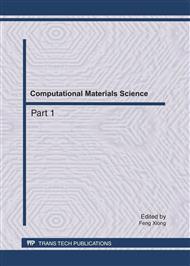[1]
J. Ureña, M. Mazo, J. García, Á. Hernández, E. Bueno: Correlation detector based on a FPGA for ultrasonic sensors. Microprocessors and Microsystems, Vol. 23 (1), pp.25-33, (1999).
DOI: 10.1016/s0141-9331(99)00002-2
Google Scholar
[2]
Á. Hernández, J. Ureña, D. Hernanz, J. García, M. Mazo, J. Dérutin, J. Serot, S. Palazuelos: Real-time implementation of an efficient Golay correlator (EGC) applied to ultrasonic sensorial systems. Microprocessors and Microsystems, Vol. 27 (8), pp.397-406, (2003).
DOI: 10.1016/s0141-9331(03)00061-9
Google Scholar
[3]
Á. Hernández, J. Ureña, J. García, M. Mazo, D. Hernanz, J. Dérutin, J. Sérot: Ultrasonic ranging sensor using simultaneous emissions from different transducers. IEEE Transactions on Ultrasonic, Ferroelectrics and Frequency Control, Vol. 51 (12), pp.1660-1670, (2004).
DOI: 10.1109/tuffc.2004.1386683
Google Scholar
[4]
F. Alvarez, J. Ureña, M. Mazo, A. Hernandez, J. García, J. Jimenez, P. Donato: Complementary sets of sequences based coding for ultrasonic array sensor. Proceedings of the IEEE Sensor Array and Multichannel Signal, Spain, June pp.211-215, (2004).
DOI: 10.1109/sam.2004.1502939
Google Scholar
[5]
C. Marziani, J. Ureña, A. Hernández, M. Mazo, F. Alvarez, J. García, P. Donato: Modular architecture for efficient generation and correlation of complementary set of sequences. IEEE Transactions on Signal Processing, Vol. 55 (5), pp.2323-2337, (2007).
DOI: 10.1109/tsp.2006.890931
Google Scholar
[6]
L. Fortuna, M. Frasca, A. Rizzo: Chaotic pulse position modulation to improve the efficiency of sonar sensors. IEEE Transactions on Instrumentation and Measurement, Vol. 52 (6), p.1809–1814, (2003).
DOI: 10.1109/tim.2003.820452
Google Scholar
[7]
Z. -J. Yao, Q. -H. Meng, G. -W. Li, P. Lin: Non-crosstalk real-time ultrasonic range system with optimized chaotic pulse position-width modulation excitation. Proceedings of IEEE Ultrasonics Symposuim, Beijing, November pp.729-732, (2008).
DOI: 10.1109/ultsym.2008.0174
Google Scholar
[8]
K. Nakahira, T. Kodama, T. Furuhashi: Design of digital polarity correlators in a multiple-user sonar ranging system. IEEE Transactions on Instrumentation and Measurement, Vol. 54 (1), p.305–310, (2005).
DOI: 10.1109/tim.2004.839753
Google Scholar
[9]
Q. Meng, Y. Zhang, Q. Liang, J. Wang: Avoiding crosstalk among mobile robot sonars with a novel coded sequence. Proceedings of IASTED International Conference Robotics and Applications, Cambridge, USA, Octobor pp.279-282, (2005).
Google Scholar
[10]
Q. Meng, Q. Liang, J. Li: Frequency-hopping pseudo-random pulse width modulation to eliminate crosstalk of sonar sensors in mobile robots. IEEE/RSJ International Conference on Intelligent Robots and Systems, Beijing, China, Octobor p.2465–2470, (2006).
DOI: 10.1109/iros.2006.281690
Google Scholar
[11]
O. Hikino, M. A. Belkerdid, D. C. Malocha: Code optimization for direct sequence spread spectrum and SAW-matched filter implementation. IEEE Transactions on Ultrasonic, Ferroelectrics and Frequency Control, Vol. 47 (4), pp.974-983, (2000).
DOI: 10.1109/58.852081
Google Scholar
[12]
Q. -H. Meng, S. -Y. Lan, Z. -J. Yao, G. -W. Li: Real-time noncrosstalk sonar system by short optimized pulse position modulation sequences. IEEE Transactions on Instrumentation and Measurement, Vol. 58 (10), pp.3442-3449, (2009).
DOI: 10.1109/tim.2009.2017663
Google Scholar
[13]
Q. -H. Meng, Z. -J. Yao, H. -Y. Peng: Improvement of Energy Efficiency via Spectrum Optimization of Excitation Sequence for Multichannel Simultaneously Triggered Airborne Sonar System. Review of Scientific Instruments, Vol. 80 (12), pp.124903-7, (2009).
DOI: 10.1063/1.3272078
Google Scholar


